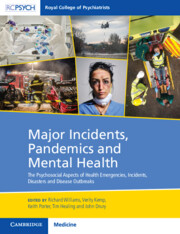 Major Incidents, Pandemics and Mental Health
Major Incidents, Pandemics and Mental Health Book contents
- Major Incidents, Pandemics and Mental Health
- Major Incidents, Pandemics and Mental Health
- Copyright page
- Dedication
- Contents
- Figures
- Tables
- Boxes
- Contributors
- Foreword by Dr Adrian James
- Foreword by Professor David Lockey
- Section 1 The Nature and Impacts of Twenty-First-Century Healthcare Emergencies
- Section 2 Clinical Aspects of Traumatic Injuries, Epidemics, and Pandemics
- Section 3 The Role of the Public in Emergencies: Survivors, Bystanders, and Volunteers
- Section 4 Responses to Meet the Mental Health Needs of People Affected by Emergencies, Major Incidents, and Pandemics
- Chapter 27 Principles for Intervening with the Wellbeing, Psychosocial, and Mental Health Needs of Mass Casualties
- Chapter 28 Facilitating Psychosocial Care for the Public After Major Incidents and During Pandemics
- Chapter 29 Mental Healthcare Required by People Who Are Affected by Major Incidents and Pandemics: Lessons from Research
- Chapter 30 Responding to the Needs of Children, Young People, and Their Families During the COVID-19 Pandemic
- Chapter 31 Social and Educational Impacts of Epidemics and Pandemics
- Chapter 32 Quarantine, Lockdown, and Isolation in the COVID-19 Pandemic
- Chapter 33 Reflections on Managing Infectious Diseases in Mental Health Units
- Chapter 34 Case Study 1: The Omagh Bomb, the Mental Health Response, and the Lessons Learned
- Chapter 35 Case Study 2: A Public Health Survey of People Exposed to the Paris Terror Attacks in November 2015 and Their Consequences
- Chapter 36 Case Study 3: Practical Approaches to Delivering Psychosocial and Mental Healthcare for the Public in the UK: Lessons Learned from a Major Incident in Manchester
- Section 5 Sustaining and Caring for Staff During Emergencies
- Section 6 Designing, Leading, and Managing Responses to Emergencies and Pandemics
- Section 7 Key Lessons for the Way Forward
- A Glossary of Selected Key Terms Used in This Book
- Index
- References
Chapter 35 - Case Study 2: A Public Health Survey of People Exposed to the Paris Terror Attacks in November 2015 and Their Consequences
from Section 4 - Responses to Meet the Mental Health Needs of People Affected by Emergencies, Major Incidents, and Pandemics
Published online by Cambridge University Press: 11 January 2024
- Major Incidents, Pandemics and Mental Health
- Major Incidents, Pandemics and Mental Health
- Copyright page
- Dedication
- Contents
- Figures
- Tables
- Boxes
- Contributors
- Foreword by Dr Adrian James
- Foreword by Professor David Lockey
- Section 1 The Nature and Impacts of Twenty-First-Century Healthcare Emergencies
- Section 2 Clinical Aspects of Traumatic Injuries, Epidemics, and Pandemics
- Section 3 The Role of the Public in Emergencies: Survivors, Bystanders, and Volunteers
- Section 4 Responses to Meet the Mental Health Needs of People Affected by Emergencies, Major Incidents, and Pandemics
- Chapter 27 Principles for Intervening with the Wellbeing, Psychosocial, and Mental Health Needs of Mass Casualties
- Chapter 28 Facilitating Psychosocial Care for the Public After Major Incidents and During Pandemics
- Chapter 29 Mental Healthcare Required by People Who Are Affected by Major Incidents and Pandemics: Lessons from Research
- Chapter 30 Responding to the Needs of Children, Young People, and Their Families During the COVID-19 Pandemic
- Chapter 31 Social and Educational Impacts of Epidemics and Pandemics
- Chapter 32 Quarantine, Lockdown, and Isolation in the COVID-19 Pandemic
- Chapter 33 Reflections on Managing Infectious Diseases in Mental Health Units
- Chapter 34 Case Study 1: The Omagh Bomb, the Mental Health Response, and the Lessons Learned
- Chapter 35 Case Study 2: A Public Health Survey of People Exposed to the Paris Terror Attacks in November 2015 and Their Consequences
- Chapter 36 Case Study 3: Practical Approaches to Delivering Psychosocial and Mental Healthcare for the Public in the UK: Lessons Learned from a Major Incident in Manchester
- Section 5 Sustaining and Caring for Staff During Emergencies
- Section 6 Designing, Leading, and Managing Responses to Emergencies and Pandemics
- Section 7 Key Lessons for the Way Forward
- A Glossary of Selected Key Terms Used in This Book
- Index
- References
Summary
On 13 November 2015, a series of terrorist attacks occurred in the Paris area. In total, 130 people were killed, 643 people were physically injured, and several thousand were psychosocially affected. Thousands of first responders were mobilised that night and during the subsequent weeks. This chapter presents a summary of the ESPA survey launched by Santé Publique France 8 to 11 months after the attacks in order to measure the traumatic impact and the use of mental health supports by people whose exposure met criterion A of the Diagnostic and Statistical Manual of Mental Disorders, Fifth Edition (DSM-5) definition of post-traumatic stress disorder (PTSD). This chapter provides two examples of the analysis and results that can be generated from the database.
Keywords
- Type
- Chapter
- Information
- Major Incidents, Pandemics and Mental HealthThe Psychosocial Aspects of Health Emergencies, Incidents, Disasters and Disease Outbreaks, pp. 257 - 263Publisher: Cambridge University PressPrint publication year: 2024


